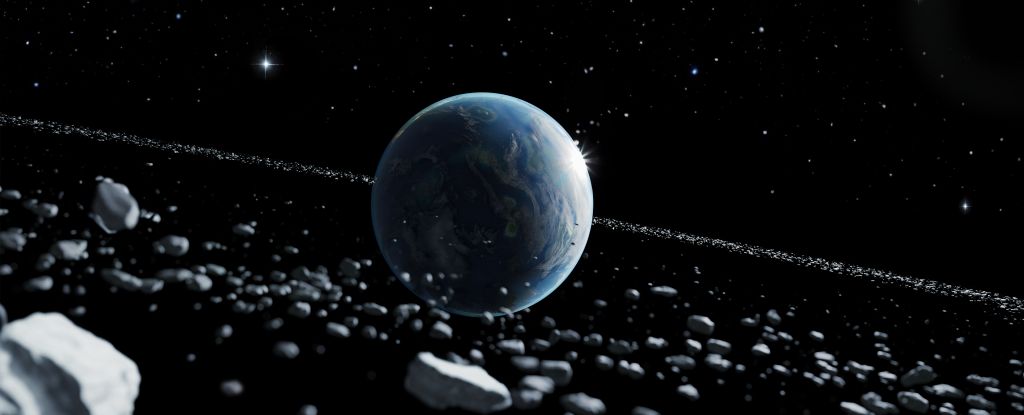Once upon a time, Earth may have sported a planetary ring of its very own.
The hypothetical ring didn’t last long, cosmically speaking – just a few tens of millions of years. But that was long enough to have left a lasting impression on Earth’s geological record, according to an analysis led by planetary scientist Andy Tomkins of Monash University in Australia.
Tomkins and his team reconstructed an unusual rise in the number of meteorite impacts known as the Ordovician impact spike, determining that a ring slowly decaying in Earth orbit could be a plausible explanation for the anomaly. And also really fun.
“I like to think about what the Earth might have looked like with a ring around it,” Tomkins told ScienceAlert, “a very different look compared with today.”
It’s a remarkable piece of detective work, and one that may, with future analysis, help explain other aspects of Earth’s history.
“Over millions of years, material from this ring gradually fell to Earth, creating the spike in meteorite impacts observed in the geological record,” Tomkins says. “We also see that layers in sedimentary rocks from this period contain extraordinary amounts of meteorite debris.”
Rings are thought to be fairly common in the Solar System. The four giant planets have rings, and there’s evidence that Mars has had one, too. This raises the question: could Earth have had a ring, somewhere in its wild past?
We are unlikely to find traces of it in space, if it ever existed; but, for a period of time during the Ordovician nearly half a billion years ago, meteorite impacts suddenly spiked for about 40 million years. There are a whole bunch of craters that emerged during this time, spaced very close together.
That close spacing is not just in time, but in location too. Tomkins and his team analyzed 21 craters that emerged during the impact spike, and found that they were all within 30 degrees latitude of the equator. This was not immediately apparent, because during the Ordovician, Earth’s continents all formed part of a supercontinent called Gondwana that has since broken up and drifted apart.
The clustering of the craters might seem curious, but it gets even weirder. The bombardment only seems to have fallen on 30 percent of the exposed landmass, all within the equatorial region. So while meteorites were far more prevalent than we see today, these specific impacts were restricted to a small section of the globe … almost as if a bunch of rocks fell from a narrow ribbon of rocks that circled Earth’s middle.
And this, according to Tomkins and his colleagues, may have been precisely what happened.
Their analysis shows that some 466 million years ago, an asteroid flew into Earth’s gravity just right. It wasn’t so close that it immediately fell down – but it was close enough to be torn apart by the tidal forces, crossing a boundary known as the Roche limit.
For a loosely-bound asteroid, the Roche limit is an altitude of about 15,800 kilometers (roughly 9,800 miles). That’s lower than some satellites – an altitude range at which the debris from the eviscerated asteroid could spool around Earth in a relatively stable orbit, decaying over time.
This is consistent with what we have observed elsewhere in the Solar System. Saturn’s rings are temporary, falling onto the planet at a pretty fast rate. And we saw comet Shoemaker-Levy 9 smack into Jupiter in 1994 – but not before the planet’s gravity tore the comet apart, creating a field of debris that circled the planet for years. So it seems eminently plausible that Earth tore apart, then ate an asteroid.
The impact clustering is one piece of evidence. There’s also a lot of meteorite material in the sediment that accumulated at the same time, and over the same timeframe. Both of these clues could be linked to the same asteroid.

And there could be another hint. Towards the end of the Ordovician roughly 445 million years ago, Earth entered a devastating ice age; the coldest in the last half a billion. A ring around Earth could have exacerbated this by casting a shadow over the surface. That’s pretty speculative at this point, and requires further investigation.
“The next stage of the research needs to be numerical modeling. We have this already underway, but I expect that other scientists will have a go at this,” Tomkins told ScienceAlert.
This modeling would recreate the break-up of the asteroid, and the formation of the ring from its debris, followed by the evolution of the ring over time. This would reveal the structure and shape that the ring could have been, and whether it could cast a large shadow. This data would then need to be given to climate scientists to see what the effects could be.
But, if it does have an effect, the implications are pretty interesting for not just understanding our own world, but climate interventions.
“Something else that was happening at this time was the Great Ordovician Biodiversification Event (rapid evolution of different organisms) – the rapid climate change creates challenges for life and the need to evolve. So if the ring drove climate change (and it’s a big if at this point), it may also have driven rapid evolution,” Tomkins said.
“A fun concept is that this would be one way to terraform an overly hot planet. So, for example, if we redirected a large asteroid into a break-up orbit around Venus, the cooling would lead to partial rain-out of the atmosphere, and possibly quite significant cooling.”
We’re probably not going to be terraforming Venus in a hurry. But isn’t it fun to imagine that we could?
The research has been published in Earth and Planetary Science Letters.





